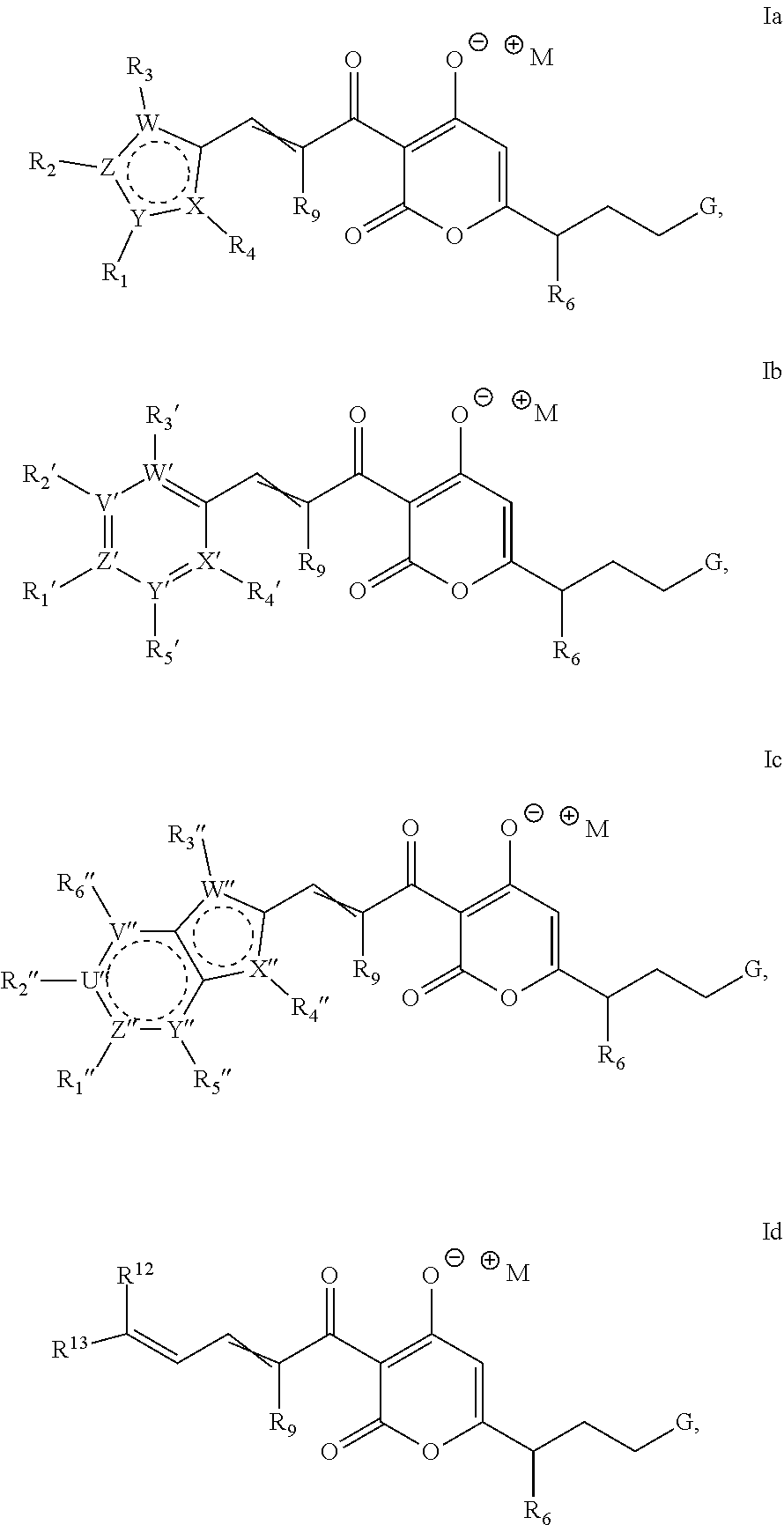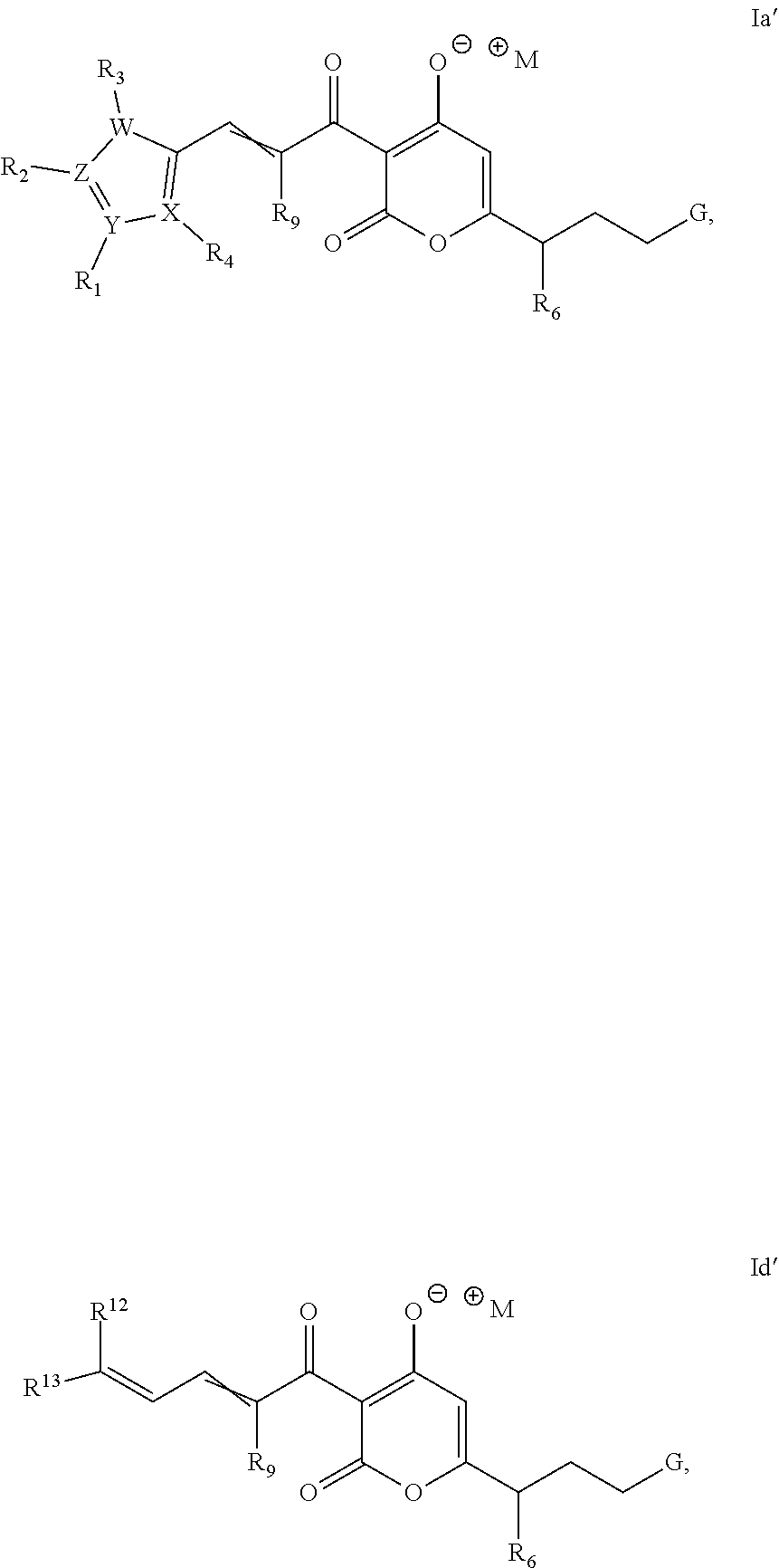Antibacterial agents: soluble salts and aqueous formulations of pyronins
a technology of aqueous formulation and antibacterial agent, which is applied in the direction of antibacterial agents, drug compositions, biocide, etc., can solve the problems of rifamycin antibacterial agent clinical utility threats, interference with the formation of a catalytically competent transcription initiation complex, etc., to improve aqueous solubility and improve the effect of aqueous solubility
- Summary
- Abstract
- Description
- Claims
- Application Information
AI Technical Summary
Benefits of technology
Problems solved by technology
Method used
Image
Examples
example 1
-6-(pent-4-en-1-yl)-2H-pyran-2-one
[0149]
[0150]4-hydroxy-6-methyl-2H-pyran-2-one (Sigma-Aldrich; 7.57 g; 60 mmol) was dissolved in 180 ml tetrahydrofuran-hexamethylphosphoramide (Sigma-Aldrich; 150:30 v / v). The solution was cooled to −78° C.; n-butyllithium (54 mL, 2.5M, 0.135 mmol; Sigma-Aldrich) was added drop-wise over 30 min. The reaction mixture was stirred 0.5 h at −78° C., another 15 minutes at 0° C. and then brought down to −78° C. 4-Bromobutene (12.2 ml; 120 mmol; Sigma-Aldrich) was added drop-wise, and the reaction mixture was stirred overnight, allowing the temperature to increase to room temperature. The reaction was quenched with 1 M HCl to pH 2 and extracted with 4×100 ml ethyl acetate, and the ethyl acetate extracts were pooled, washed with 100 ml brine, dried over anhydrous sodium sulfate, and evaporated to an oil. The product was isolated via silica chromatography (ethyl acetate / hexanes gradient) on a CombiFlash Companion. Yield: 10.53 g (97%). 1H NMR (400 MHz, CDCl3...
example 2
-6-(pent-4-en-1-yl)-3-propionyl-2H-pyran-2-one
[0151]
[0152]N,N′-Diisopropylcarbodiimide (Sigma-Aldrich; 0.42 ml; 2.71 mmol), 4-(dimethylamino)pyridine (Sigma-Aldrich; 30 mg; 0.25 mmol), propionic acid (Sigma-Aldrich; 0.204 mL, 2.73 mmol) and 4-hydroxy-6-(pent-4-en-1-yl)-2H-pyran-2-one (Example 1, 0.443 g, 2.46 mmol) were dissolved in 7 ml toluene and heated 4 h in a 40 mL screw cap pressure vial at 100° C. under argon. Upon cooling to 25° C., 14 ml ethyl acetate was added to the reaction mixture to precipitate the by-product DIC urea. The reaction mix was filtered, the solid was triturated with 100 mL ethyl acetate. The organic solutions were pooled and washed with 25 ml 1M HCl, 25 ml water, and 25 ml brine, and was dried over anhydrous sodium sulfate. The product was isolated via silica chromatography dichloromethane) Yield: 0.331 g (57%). 1HNMR (400 MHz, CDCl3): δ 5.96 (s, 1H), 5.80 (m, 1H), 5.05-4.95 (m, 2H), 3.10 (q, 2H), 2.50 (t, 2H), 2.10 (m, 2H), 1.80 (m, 2H), 1.18 (t, 3H).
example 3
)-6-(4-hydroxy-2-oxo-3-propionyl-2H-pyran-6-yl)hex-2-enoate
[0153]
[0154]To 4-hydroxy-6-(pent-4-en-1-yl)-3-propionyl-2H-pyran-2-one (Example 2; 1.5 g; 6.3 mmol) and methyl crotonate (Sigma-Aldrich; 4.41 ml, 41.6 mmol) in 8 ml anhydrous t-butyl methyl ether, was added Hoveyda-Grubbs Catalyst II (Sigma-Aldrich; 130 mg, 0.21 mmol), and the reaction mixture was heated 16 h at 50° C. The solvent was evaporated, and the product was isolated via silica chromatography (ethyl acetate / hexanes gradient) on a CombiFlash Companion. Yield: 1.3 g (70%). 1H NMR (400 MHz, CDCl3): δ 6.90 (m, 1H), 5.90 (s, 1H), 5.82 (d, 2H), 3.70 (s, 3H), 3.10 (q, 2H), 2.50 (t, 2H), 2.10 (m, 2H), 1.80 (m, 2H), 1.18 (t, 3H).
PUM
| Property | Measurement | Unit |
|---|---|---|
| Fraction | aaaaa | aaaaa |
| Concentration | aaaaa | aaaaa |
| Molar density | aaaaa | aaaaa |
Abstract
Description
Claims
Application Information
 Login to View More
Login to View More - R&D
- Intellectual Property
- Life Sciences
- Materials
- Tech Scout
- Unparalleled Data Quality
- Higher Quality Content
- 60% Fewer Hallucinations
Browse by: Latest US Patents, China's latest patents, Technical Efficacy Thesaurus, Application Domain, Technology Topic, Popular Technical Reports.
© 2025 PatSnap. All rights reserved.Legal|Privacy policy|Modern Slavery Act Transparency Statement|Sitemap|About US| Contact US: help@patsnap.com



